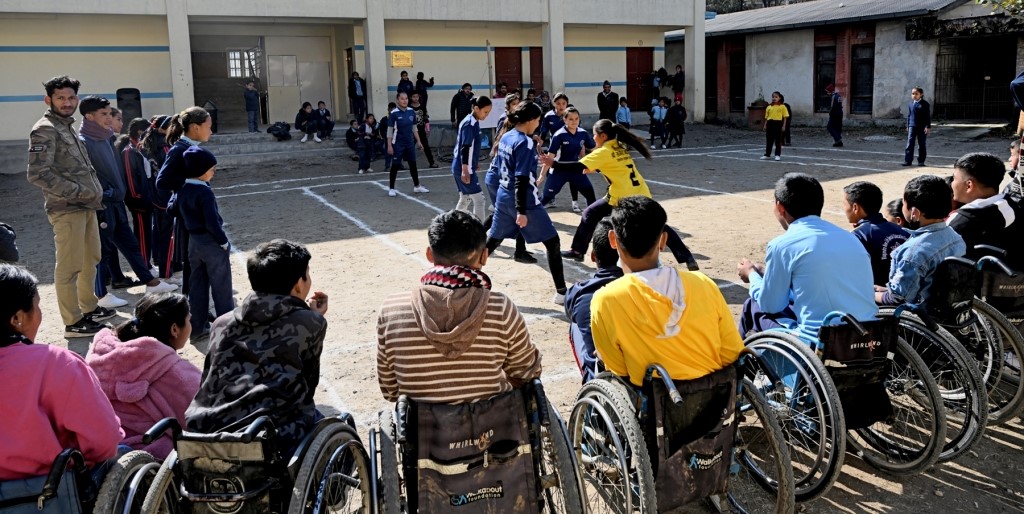Birendra Giri, a visually impaired student from Nepal, took his 12th-grade exam this month. The exams had been postponed for seven months due to COVID-19, and Birendra is worried he was not well-prepared.
“I did not have any Braille books at home," he says. “I had to rely on a few audio learning materials.”
Another student, Shankar Rauniyar, was slightly luckier. He was able to borrow Braille books from school, attend informal rotational classes and consult with his teachers over the phone. But he is worried too.
“I used to earn very good grades but now I fear I will lose my grades because I missed out on learning,” says Shankar.
In Nepal, children with disabilities face serious obstacles. Only about 50% of schools in Nepal are providing some form of remote teaching-learning support to children with disabilities.
Around 8.2 million students in Nepal faced disruptions in their education and learning due to school closures from the pandemic. But for students like Birendra and Shankar the challenges are even greater as they lack access to appropriate distance learning resources.
Disruptions in learning
In Nepal, children with disabilities face serious obstacles. A recent survey of teachers conducted by the World Bank shows that only about 50% of schools in Nepal are providing some form of remote teaching-learning support to children with disabilities.
Similarly, a recent study carried out by Humanity and Inclusion shows that 83% of parents and caregivers of children with disabilities feared that their children will fall behind in learning due to COVID-19.
Amid the pandemic, as we design and deliver remote learning options, it will be critical to rethink and accommodate the needs of children with disabilities. This requires applying an inclusive lens to ensure every child in Nepal can access and participate in learning.
Ensuring learning is equitable and accessible
In response to the pandemic’s impacts on learning, the government has introduced several measures to make learning more equitable and accessible. The government’s multi-modal learning strategy includes audio and visual learning materials as well as the distribution of learning packages to children who have no access to media.
The recently approved school reopening framework includes an emergency action plan where teachers are able to check-in and visit the homes of children with disabilities.
Different international and national organizations have also stepped in. For instance, the National Federation of the Deaf Nepal has prepared sample lessons in sign language for Grades 1 to 10 in collaboration with the Center for Education and Human Resource Development.
In September, the Government of Nepal and the World Bank signed a financing agreement of $10.85 million under the Global Partnership for Education (GPE) COVID-19 accelerated funding. Designed to be implemented in collaboration with local education groups, the grant addresses the needs of children with disabilities, including ensuring that remote learning solutions are accessible to all children and that children can safely return to schools and continue learning when the situation is favorable.
The Nepal IEI work aims at enhancing the government’s capacity to effectively deliver disability-inclusive education by providing recommendations and support to strengthen systems for disability inclusive education.
Inclusive Education Initiative
Nepal is also one of the countries benefiting from the Inclusive Education Initiative (IEI) Grant, managed by the World Bank and supported by the Norwegian Agency for Development Cooperation and the UK’s Foreign, Commonwealth, and Development Office (FCDO).
The Nepal IEI work aims at enhancing the government’s capacity to effectively deliver disability-inclusive education by providing recommendations and support to strengthen systems for disability-inclusive education and piloting innovative school-level interventions that can be scaled-up.
A recent event focused on Pivoting to Inclusion: Leveraging Lessons from the COVID-19 Crisis for Learners with Disabilities brought together government, development partners, I/NGOs and disabled people’s organizations to work on the inclusive education agenda and discuss the importance of ensuring an inclusive design in all phases of the pandemic response.
As Nepal is preparing for its next ten-year education sector plan, as a successor to the current School Sector Development Plan, it is an opportune time to build back better and ensure that Nepal’s education system is inclusive and addresses the learning challenges of children with disability.
Authors: MAYA SHERPA; CRISTIAN AEDO; KARTHIKA RADHAKRISHNAN-NAIR
Originally posted on World Bank Blog End Poverty in South Asia

